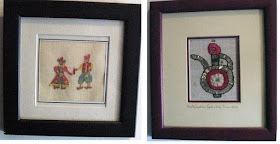In
the “Antiques and The Arts” newspaper, some years ago, I came across a
small item that thrilled me. It said
that Barack Obama’s mother, Ann Dunham, wove textiles for wall hangings early
in her life, and when she moved to Indonesia with her son in the 1960’s, she
began to amass a collection of the vibrant batik textiles of the country. “She did not acquire rare or expensive
pieces, but rather contemporary examples that were an expression of a living tradition,
patterned with both classic designs and those of passing fashion.”
Later,
I learned, when Ann was studying anthropology at the University of Hawaii, she
tried to find ways to help craftspeople.
She worked with the Ford Foundation in Jakarta and with USAID and the
World Bank, and set up micro-credit projects in Indonesia, Pakistan and Kenya
to benefit poor women making textiles.
I
have always considered textile-making (weaving and embroidery) a fascinating
art form. In many countries this is the only medium of artistic expression
available to women and the only way they can earn money. Whenever I travel, I buy textiles –ideally
from the women who created them. Now my walls are covered with antique American
quilts, Mexican huipils, Haitian voodoo flags and Greek embroidered table runners.
Most pieces
cost under $100 but they’re priceless, because they embody the maker’s artistic
talent as well as (in some cases) their religious or political beliefs and
their dreams, for example the wedding couple on a tablecloth that a young
Greek girl embroidered as part of her dowry. (The teapot is also from an Anatolian tablecloth.)
Around
1970 I got interested in antique American quilts. On our second floor stair
landing I hung a “Tumbling Blocks” quilt behind a sea captain’s chest full of
teddy bears.
The
section from an unfinished velvet and silk Victorian quilt is called “Windmill
Blades” and the large “Barn Raising” quilt on the staircase wall is from a very old variation on the
Log Cabin pattern.
Mexican
and Guatemalan embroideries fascinate me with their sophisticated and wild use
of color. I’ve decorated the wall of my studio (shown at top) with antique, wonderfully embroidered Mexican huipils. The design of each blouse indicates the native
village of the woman who wears it.
The
lady posing above with her work is Maria, whom we met in the marketplace of San
Cristobal, Chiapas, Mexico. She was the
best among the many women weavers and embroiderers who crowded the
marketplace. (San Cristobal is heaven
for the collector of textiles.)
Near
the border of Guatemala I found the embroidery at left made by a Sandinista woman who
was also selling dolls with faces masked like Comandante Marcos. The pillow at the right, made in Guatemala, looks to me like a man walking in a graveyard. Could this be a memorial or something to do with the Day of the Dead?
Daughter
Eleni, who studied folklore and mythology, introduced me to the sequined voodoo
flags made in Haiti and used in religious rites. They are usually made (and signed) by men
and they represent the gods who take possession of the worshiper. These sequin flags and the artists who make
them are taken very seriously as art now, which means they can be very
expensive. The
two large ones represent La Sirene—-The Enchantress—and Baron Samedi—who
mitigates between life and death.
Textile
artists reflect the life they see around them—the Greek wall hanging is an
island scene with table, chairs and cat. The
festive wedding scene (brought from Pakistan by Eleni) shows a wedding party
celebrating beneath an umbrella.
This
exquisite, antique Chinese embroidery (now framed under glass) was in a box of textiles that I bought for $75. The detailed work and the wonderful
reproduction of all those birds, animals and flowers make it beyond price.
The knots are so small, I think it must
include the “forbidden knot” that would make the sewers eventually lose their sight.
Finally there is lace: a simple lace handkerchief and lace runner that I'm told represents French cathedrals. It may sound silly to buy pieces like this for a few dollars and then spend a great deal more to frame them, but I do it, because I consider them found art.
It
cost a lot more than a few dollars when I encountered this stunning set of
Madeira lace work – ten place mats and a table runner—at a summer yard sale
near our village common. They came with
their own blue brocade carrying case plus a handwritten note that it was “Made
on the Island of Madeira for the Beede Family, makers of Madeira Wines”.
I
couldn’t resist, telling myself it was for a daughter’s trousseau, but let’s
face it, young women today have no use for fragile lace tablecloths, napkins and embroidered linens,
so the fine Madeira set now lives with the “turkey work” embroidered pillow
shams, the hand-smocked baby dresses (mine! from 75 years ago!). and the
Dresden Plate quilt that my grandmother made for my mother’s wedding in 1932—all
stored in tissue and special boxes, hidden under my bed.













No comments:
Post a Comment